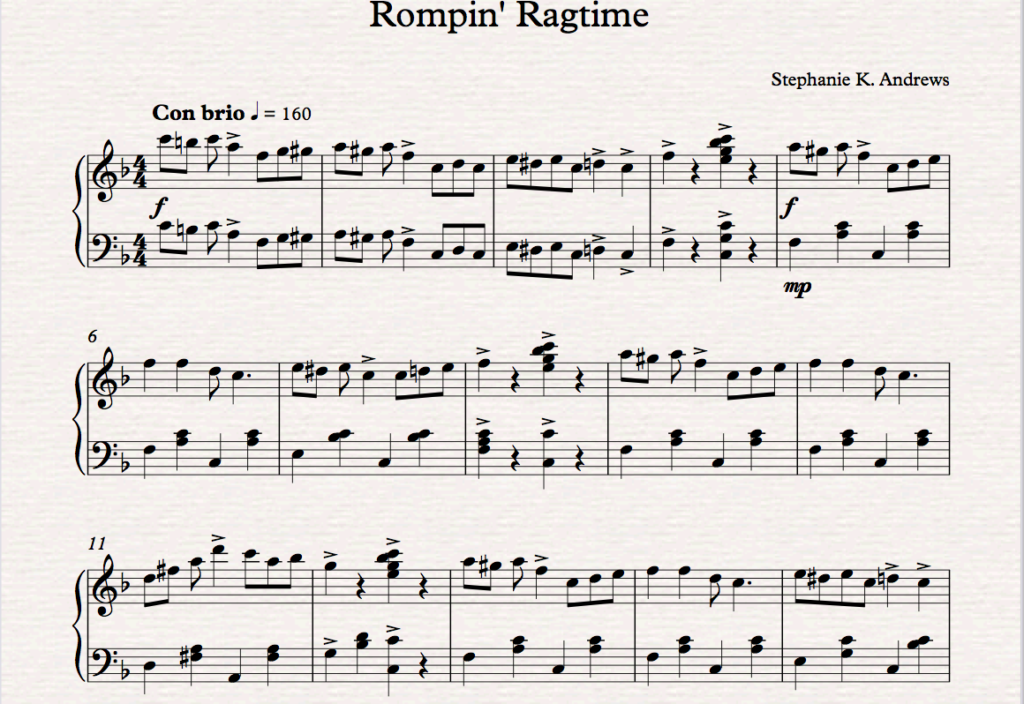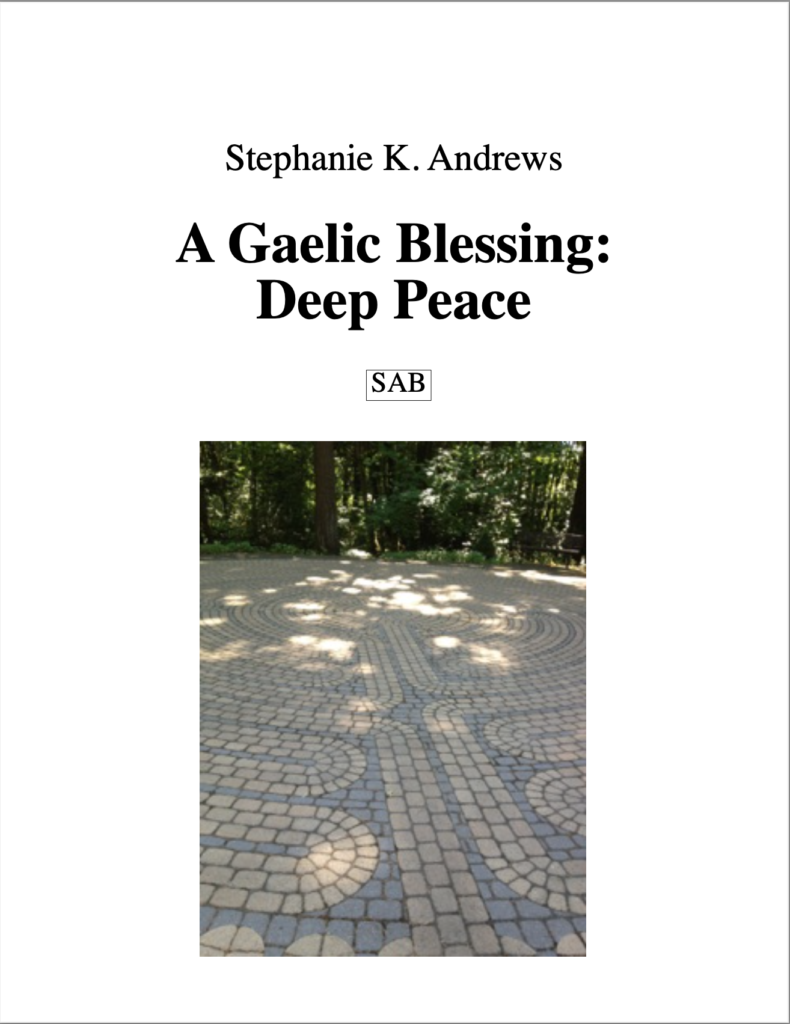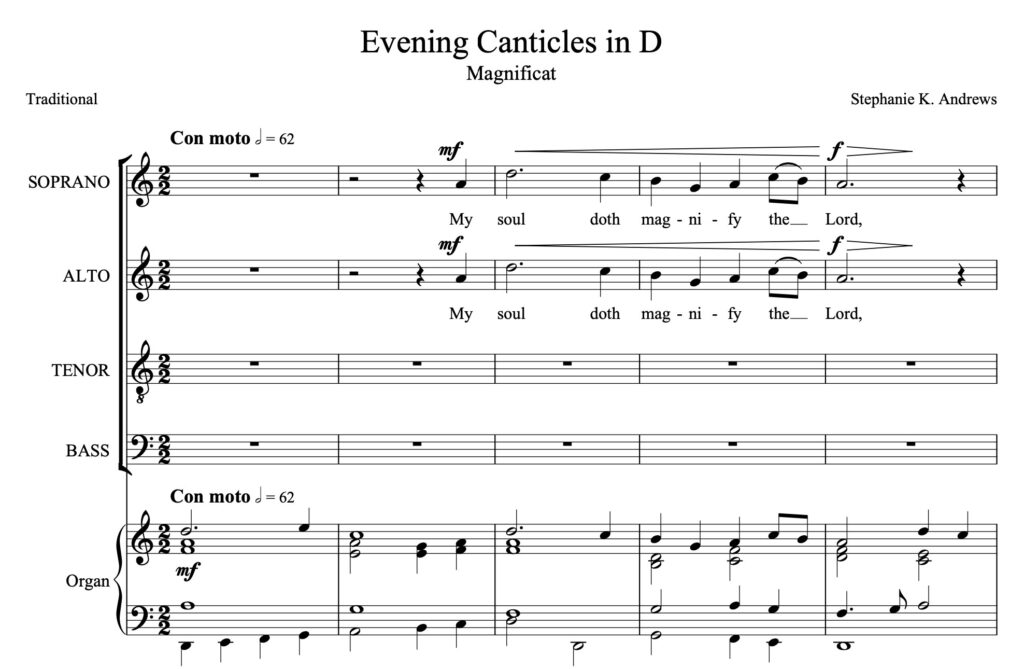Piano Solos
Rompin’ Ragtime

“Rompin’ Ragtime” is an intermediate piano solo composed in ragtime style. Enjoy!
Reflection in Blue

“Reflection in Blue” is an intermediate piano solo with rich blues harmonies and elegant phrasing.
Choral Music
A Gaelic Blessing

“A Gaelic Blessing” is scored for SAB choir, piano/organ, and flute. This gorgeous blessing in the Gaelic tradition is accompanied by Celtic stylings in the vocals and accompaniment. Suitable for any occasion and highly accessible.
Evening Canticles in D

The Evening Canticles in D are scored for SATB choir (intermediate difficulty) and organ.
O Magnum Mysterium

“O Magnum Mysterium,” for SATB voices with divisi and organ accompaniment, was composed in Austin, Texas in mid-2020 and lovingly dedicated to the Parish Choir at All Saints’ Episcopal Church in Austin, Texas, the composer’s home parish for over a decade, and to Gregory Eaton, Organist-Choirmaster of All Saints’. From measures 17-21, homage is paid to Irish composer Sir Charles Villiers Stanford (1852-1924), whose Beati quorum via has been sung by the All Saints’ Parish Choir on a number of occasions.
Written in the midst of a pandemic during which choirs could not sing together without risk of infection, this was composed in anticipation of the joyous day when we are all able to once again sing together, and as a reminder that, even in the darkest of times, wonder, beauty, awe, mystery, and the love and light of Christ remain with us now and forevermore.
Deep in the Night

Composed in 2018 and dedicated to a young man who had passed away, this piece with words by poet Sara Teasdale is set for unison voices with piano and cello accompaniment. It is accessible for young/beginning choirs.
O Sacrum Convivium

Composed for Inversion Ensemble’s Da Capo women’s chorus of Austin, Texas in May 2019, “O Sacrum Convivium” is a sacred work scored for a capella treble voices (SSAA). The text is a prayer honoring Holy Communion, a sacred mystery in which Christ is received, bringing grace to the soul with a promise of future glory. With the distress so currently pervasive in our world, it is the composer’s prayer that in this work the listener may find a place of respite, grace, peace, and solace.
O Salutaris Hostia

“O Salutaris Hostia” was composed in late summer 2019 as a companion piece to “O Sacrum Convivium,” which Dr. Andrews wrote for treble voices in the spring of 2019. The text of “O Salutaris Hostia” was written by St. Thomas Aquinas in the 13th century and is the last two stanzas of a larger hymn that St. Thomas wrote about Christ’s institution of the Eucharist at the Last Supper. Traditionally, this text is sung during Eucharistic services.
It is my prayer that, as with “O Sacrum Convivium,” those who hear this work may find respite, grace, and peace in the midst of a troubled world.
Crystal Veil Suite

Crystal Veil Suite_tenorsax
Crystal Veil Suite was composed in 2018 for REVEL, an Austin, Texas based classical music group led by Dr. Carla McElhaney, and for Chorus Austin, also of Austin, Texas, Ryan Heller, Artistic Director. The premiere of the piece took place on December 1, 2018, at the “Existential Solstice” concert, part of REVEL’s “Radio Project”concert series. The “Existential Solstice” concert, a collaboration between REVEL and Chorus Austin, featured music and poetry meant to elicit vivid imagery of winter scenes. As a lifelong Texan, this required a stretching of my creativity, as you well might imagine. The A section of the first movement, “The Snow,” was written in Phyrigian mode to evoke the melancholy mood that may accompany a long winter, with descending patterns in the tenor sax and the right hand of the piano painting a gentle snowfall. The B section contrasts with a faster tempo, suggesting an intensification of the snowfall, before returning to the melancholic A section. The second movement, “Frost and Wind,” paints a snowstorm with its faster tempo, swirling winds in the right hand of the piano and in the choir, and bitter frost evinced in all voices. Finally, in the third movement, “Snow,” a shift to the major mode and tranquil melodic lines suggests a return to a gentle snowfall following the storm, with contemplative motives in all voices, until a lone robin’s voice and sunlight bring us hope of spring’s return.